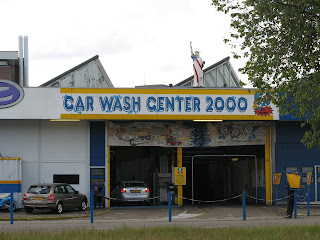It's a spectacular sight: I know of none other in Europe to equal it. ... This is a square whose only buildings are the ancient and untouched Guild Halls of the Middle Ages. Each is festooned with a brilliantly-colored flag, and the cornices of the buildings are covered in pure gold leaf. Stand in this square, and you will be thrillingly transported to the world of Breughel and Van Eyck, of Rubens and Rembrandt.
He's right: the Grand Place is indeed spectacular, if mildly overwhelming in its Gothic grandeur. I half-expected a fanfare of trumpets to fill the air as Lee and I stepped into the sprawling square, or to catch a glimpse of a ghostly regiment of medieval soldiers on white steeds lining up in formation in front of City Hall. The whole space seems to echo with history and import and opulence in such a powerful, hypnotic way that you can't help but feel majestic and important yourself. You might be sitting on a curb, eating a Belgian waffle, but that is one epic waffle. Your paper plate suddenly looks like silver. The busker a ways down the sidewalk? He's your personal musician, a member of your High Court, retained purely to entertain you as you feast. It's good to be Tourist King.
This is, in short, an impressive place. No wonder it's a UNESCO World Heritage Site.
So why, I ask you, do they feel the need to liven it up with LOUD, SCARY LIGHT SHOWS?
Lee and I were staying in a hostel mere steps off the Grand Place. We were settling in for an early bedtime (okay, Lee was doing that; I was compiling my notes) at about 10 p.m. our first night in Brussels, when we heard an earth-shattering blast of Wagner-or-something--the sort of ominous and over-the-top opera music played during the opening frames of Hollywood battle scenes, as the army of bad guys appears on the horizon. The music seemed to be on an endless crescendo, the intensity and volume rising with each passing minute. It was terrifying. We looked out the window for the Four Horseman of the Apocalypse but saw nothing. Arming ourselves with, um, pens--we're writers, after all--we went outside to investigate. This is what we found on the Grand Place (for the full effect, turn your speaker to 11, then put a megaphone in front of it and put your ear in front of the megaphone):
(Just watch ten or twenty seconds to get a feel for it; the spectacle doesn't translate to video very well, and my hand was less than perfectly steady, so there's really no reason to watch the entire video.)
Lee and I were staying in a hostel mere steps off the Grand Place. We were settling in for an early bedtime (okay, Lee was doing that; I was compiling my notes) at about 10 p.m. our first night in Brussels, when we heard an earth-shattering blast of Wagner-or-something--the sort of ominous and over-the-top opera music played during the opening frames of Hollywood battle scenes, as the army of bad guys appears on the horizon. The music seemed to be on an endless crescendo, the intensity and volume rising with each passing minute. It was terrifying. We looked out the window for the Four Horseman of the Apocalypse but saw nothing. Arming ourselves with, um, pens--we're writers, after all--we went outside to investigate. This is what we found on the Grand Place (for the full effect, turn your speaker to 11, then put a megaphone in front of it and put your ear in front of the megaphone):
(Just watch ten or twenty seconds to get a feel for it; the spectacle doesn't translate to video very well, and my hand was less than perfectly steady, so there's really no reason to watch the entire video.)







